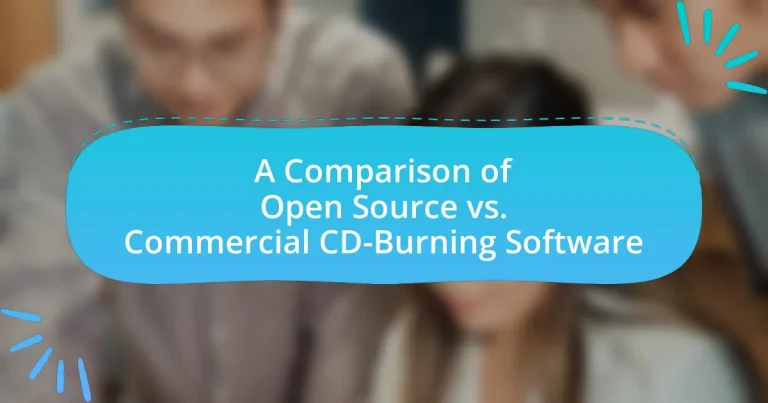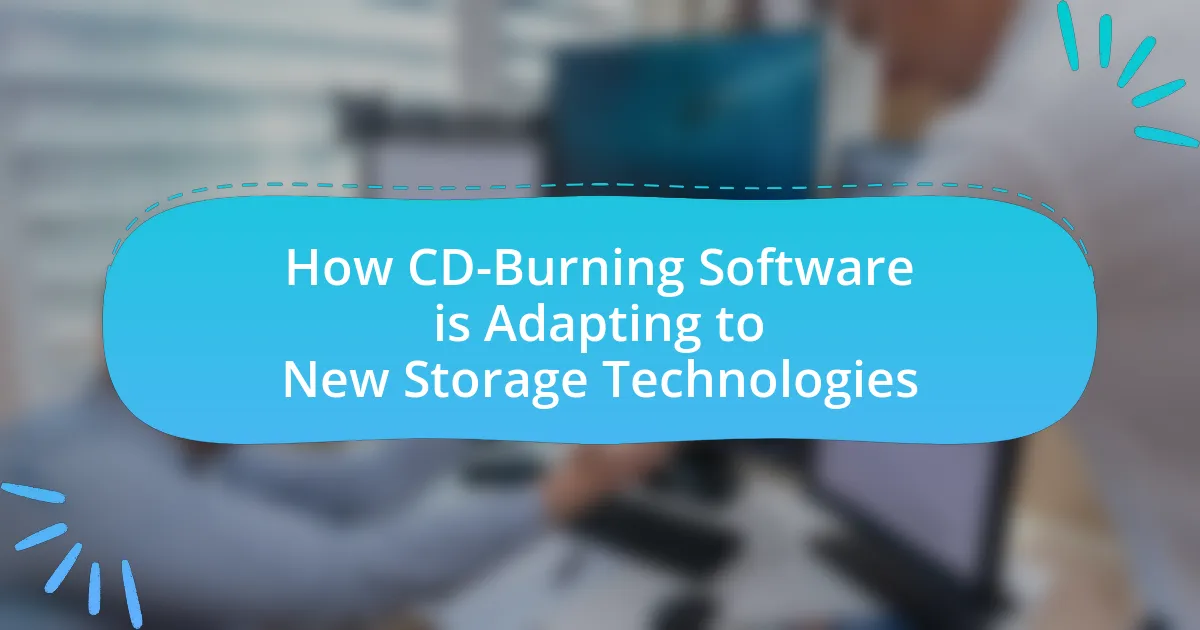The article provides a comprehensive comparison between Open Source and Commercial CD-Burning Software, highlighting key differences in licensing models, functionality, and user experience. Open Source software, such as Brasero and K3b, is typically free, customizable, and community-supported, while Commercial software like Nero and Roxio requires purchase and offers polished interfaces and dedicated customer support. The discussion includes the advantages and disadvantages of each type, cost implications, and the impact of licensing on user rights, ultimately guiding users in selecting the most suitable CD-burning solution based on their specific needs and preferences.
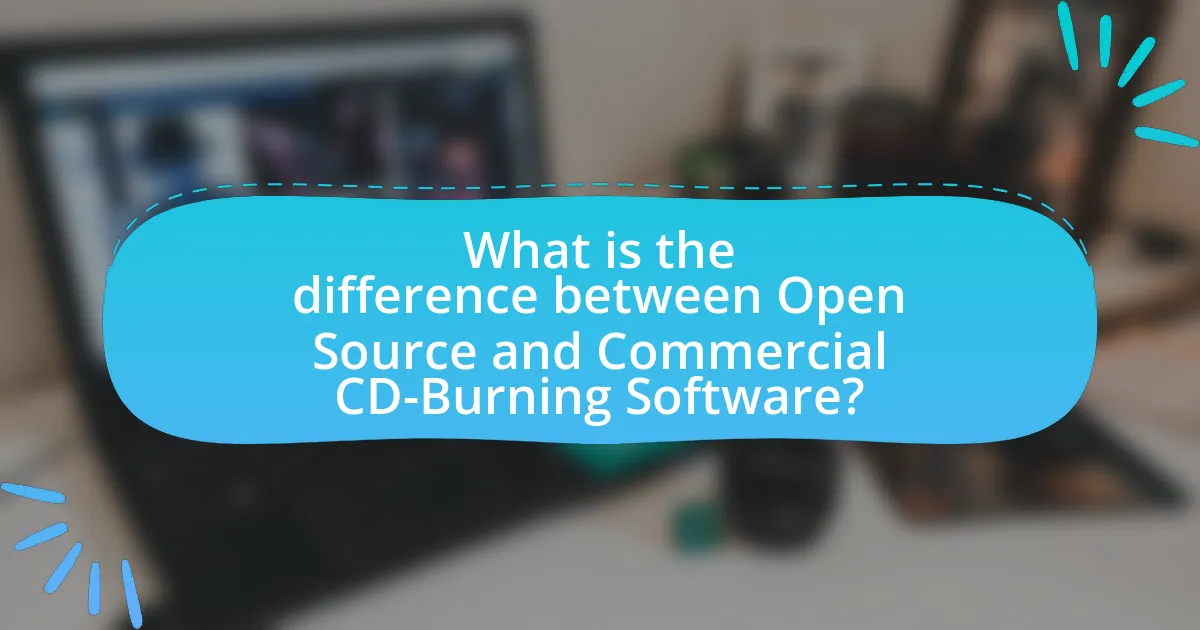
What is the difference between Open Source and Commercial CD-Burning Software?
Open Source CD-burning software is typically free to use, modify, and distribute, while Commercial CD-burning software requires a purchase or subscription for access and often includes customer support and regular updates. Open Source options, such as Brasero or K3b, allow users to customize the software to their needs, whereas Commercial software, like Nero or Roxio, often provides a more polished user experience with additional features and technical support. The distinction lies in the licensing model and the level of user control versus convenience offered by each type of software.
How do Open Source CD-Burning Software and Commercial CD-Burning Software differ in functionality?
Open Source CD-Burning Software typically offers basic functionality for burning CDs, such as data and audio disc creation, while Commercial CD-Burning Software often includes advanced features like enhanced user interfaces, technical support, and additional tools for editing and managing media. Open Source options, like Brasero or K3b, are generally free and community-supported, which may limit their user experience and feature set compared to Commercial options like Nero or Roxio, which provide polished interfaces and customer service. The differences in functionality stem from the development model; Open Source relies on community contributions, which can lead to variability in features and updates, whereas Commercial software is developed with a profit motive, ensuring consistent quality and support.
What features are commonly found in Open Source CD-Burning Software?
Open Source CD-Burning Software commonly includes features such as multi-session support, data verification, and the ability to create audio CDs from various file formats. Multi-session support allows users to add data to existing discs without erasing previous content, enhancing usability. Data verification ensures that the data written to the disc matches the original files, reducing the risk of errors. Additionally, these software solutions often support a wide range of file formats, enabling users to create both data and audio CDs efficiently. Popular examples of such software include Brasero and K3b, which exemplify these features in practice.
What features are typically included in Commercial CD-Burning Software?
Commercial CD-burning software typically includes features such as user-friendly interfaces, support for various disc formats (CD, DVD, Blu-ray), advanced burning options (like multi-session and disc-at-once), and the ability to create audio CDs, data discs, and ISO images. Additionally, these software solutions often provide tools for disc labeling, error checking, and integration with other software for media management. The inclusion of these features is validated by the widespread use of commercial software like Nero and Roxio, which are known for their comprehensive functionalities and ease of use in both personal and professional settings.
What are the licensing models for Open Source and Commercial CD-Burning Software?
Open Source CD-burning software typically uses licenses such as the GNU General Public License (GPL), Apache License, or MIT License, which allow users to freely use, modify, and distribute the software. In contrast, Commercial CD-burning software generally operates under proprietary licenses, which restrict usage, modification, and distribution, requiring users to purchase a license for access. For example, software like Nero Burning ROM is sold under a commercial license, while applications like Brasero are available under open-source licenses like GPL. This distinction highlights the fundamental differences in user rights and software accessibility between the two models.
How does the licensing of Open Source software impact user rights?
The licensing of Open Source software significantly enhances user rights by granting users the freedom to use, modify, and distribute the software. This is primarily due to licenses like the GNU General Public License (GPL), which explicitly allows users to access the source code, enabling them to adapt the software to their needs. Furthermore, Open Source licenses often require that any derivative works also remain open, thereby protecting the rights of future users and contributors. This contrasts with proprietary software, where user rights are typically limited to usage under strict terms, often prohibiting modification or redistribution. The impact of Open Source licensing on user rights is evident in the increased control and flexibility it provides, fostering a collaborative environment that benefits the broader community.
What are the implications of Commercial software licensing for users?
Commercial software licensing imposes specific restrictions and obligations on users, affecting their usage rights and responsibilities. Users typically must adhere to terms that limit how the software can be installed, used, and distributed, which can restrict flexibility and control over the software. For instance, many commercial licenses prohibit reverse engineering or modification, which can hinder users’ ability to customize the software to meet their needs. Additionally, users often face costs associated with purchasing licenses, which can vary significantly based on the number of users or devices, impacting budget considerations. Furthermore, commercial software may come with support and updates, providing users with ongoing assistance and improvements, but this can also create dependency on the vendor for critical updates and security patches.
What are the cost implications of using Open Source versus Commercial CD-Burning Software?
Open Source CD-burning software typically incurs no licensing fees, making it a cost-effective option for users, while Commercial CD-burning software often requires upfront purchase costs or subscription fees. For instance, popular open-source options like ImgBurn and CDBurnerXP are free to use, allowing users to save on software expenses. In contrast, commercial software such as Nero or Roxio can range from $30 to $100, depending on the features offered. Additionally, open-source software may require users to invest time in learning and troubleshooting, which can translate to indirect costs, whereas commercial software often provides customer support, potentially reducing the time spent on issues.
What are the potential hidden costs associated with Commercial CD-Burning Software?
Potential hidden costs associated with commercial CD-burning software include licensing fees, ongoing subscription costs, and potential charges for technical support or updates. Licensing fees can vary significantly based on the number of users or installations, leading to unexpected expenses if the software is scaled. Ongoing subscription costs may arise if the software operates on a subscription model, which can accumulate over time. Additionally, some commercial software may require users to pay for technical support or updates beyond the initial purchase, further increasing total ownership costs. These factors can lead to a total cost of ownership that exceeds initial expectations, making it essential for businesses to evaluate all potential expenses before committing to commercial CD-burning solutions.
How can Open Source CD-Burning Software save users money?
Open Source CD-Burning Software saves users money by eliminating licensing fees associated with commercial software. Users can download and use these programs for free, which significantly reduces the overall cost of software for burning CDs. For instance, popular open-source options like ImgBurn and CDBurnerXP provide robust features without any financial investment, unlike commercial alternatives that may charge upwards of $30 for similar functionalities. Additionally, open-source software often has a community-driven support system, reducing the need for paid technical assistance, further contributing to cost savings.
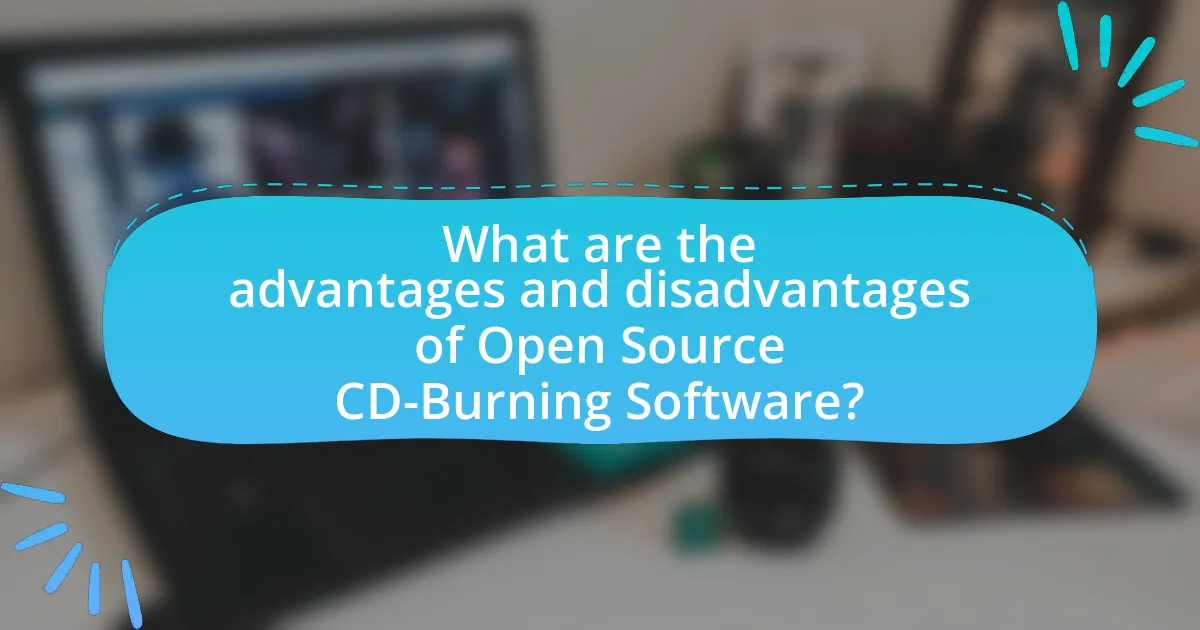
What are the advantages and disadvantages of Open Source CD-Burning Software?
Open Source CD-Burning Software offers several advantages and disadvantages. The primary advantage is that it is typically free to use, allowing users to access and modify the software without financial constraints. This accessibility fosters a community-driven development model, leading to frequent updates and improvements based on user feedback. Additionally, open source software often provides greater transparency, as users can inspect the code for security vulnerabilities or bugs.
Conversely, the disadvantages include potential lack of customer support, as open source projects may not have dedicated teams to assist users. This can lead to challenges in troubleshooting and resolving issues. Furthermore, compatibility with various hardware and operating systems may not be as robust as commercial alternatives, which are often optimized for specific environments. Lastly, the user interface of open source software may not be as polished or user-friendly as that of commercial products, potentially deterring less tech-savvy users.
What are the key benefits of using Open Source CD-Burning Software?
The key benefits of using Open Source CD-Burning Software include cost-effectiveness, flexibility, and community support. Open source software is typically free to use, which eliminates licensing fees associated with commercial alternatives. This financial advantage allows users to allocate resources elsewhere. Additionally, open source CD-burning software offers flexibility in customization, enabling users to modify the software to meet specific needs or preferences. Furthermore, a strong community often surrounds open source projects, providing users with access to shared knowledge, troubleshooting assistance, and regular updates, which enhances the overall user experience and software reliability.
How does community support enhance Open Source CD-Burning Software?
Community support enhances Open Source CD-Burning Software by providing collaborative development, troubleshooting assistance, and feature enhancements. This collective effort allows developers to rapidly identify and fix bugs, as seen in projects like Brasero and K3b, where community feedback directly influences software updates. Additionally, community contributions often lead to the integration of diverse features that cater to various user needs, improving overall functionality and user experience. For instance, the active user forums and contribution platforms like GitHub enable users to suggest improvements and share custom plugins, which enrich the software ecosystem.
What customization options are available with Open Source CD-Burning Software?
Open source CD-burning software offers various customization options, including user interface modifications, plugin support, and advanced configuration settings. Users can often change themes, layouts, and toolbars to suit their preferences, enhancing usability. Additionally, many open source programs allow the integration of plugins that extend functionality, such as adding support for different file formats or additional burning features. Advanced configuration settings enable users to adjust parameters like burn speed, error correction, and disc image formats, providing a tailored experience that meets specific needs. These features highlight the flexibility and adaptability of open source solutions compared to their commercial counterparts.
What challenges do users face with Open Source CD-Burning Software?
Users face several challenges with Open Source CD-Burning Software, including limited user support, compatibility issues, and a steeper learning curve. Limited user support arises because many open-source projects rely on community forums rather than dedicated customer service, making it difficult for users to resolve issues quickly. Compatibility issues often occur with different operating systems and hardware, as open-source software may not be optimized for all configurations, leading to functionality problems. Additionally, the steeper learning curve is a result of less intuitive interfaces compared to commercial alternatives, which can deter less tech-savvy users from effectively utilizing the software.
How does the learning curve for Open Source software compare to Commercial software?
The learning curve for Open Source software is generally steeper compared to Commercial software. Open Source software often lacks formal documentation and user support, which can make it challenging for new users to navigate. In contrast, Commercial software typically provides structured tutorials, customer support, and user-friendly interfaces, facilitating easier onboarding. For example, studies have shown that users of Commercial software report higher satisfaction and quicker proficiency due to these resources, while Open Source users may spend more time troubleshooting and seeking community assistance.
What are the potential security concerns with Open Source CD-Burning Software?
Open Source CD-Burning Software can pose several security concerns, primarily due to its accessibility and the potential for malicious code insertion. Since the source code is publicly available, it allows anyone to inspect, modify, or contribute to the software, which can lead to vulnerabilities if not properly managed. For instance, if a contributor introduces harmful code, it may go unnoticed by the community, exposing users to risks such as data theft or system compromise. Additionally, the lack of formal support and regular updates in some open-source projects can leave known vulnerabilities unpatched, further increasing security risks. According to a study by the University of California, Berkeley, open-source software is often more susceptible to security flaws due to the varying levels of expertise among contributors, which can lead to inconsistent code quality.
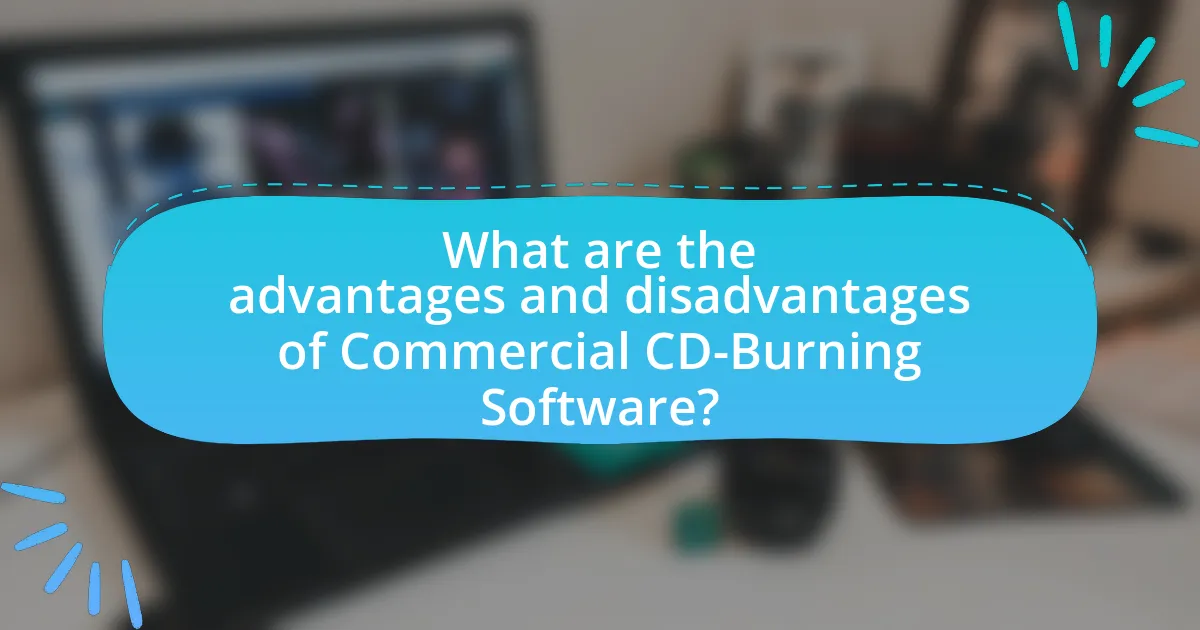
What are the advantages and disadvantages of Commercial CD-Burning Software?
Commercial CD-burning software offers several advantages and disadvantages. The primary advantage is its user-friendly interface, which simplifies the burning process for users of all skill levels. Additionally, commercial software often includes advanced features such as enhanced error correction, support for a wider range of formats, and regular updates, ensuring compatibility with the latest hardware and operating systems. For example, software like Nero and Roxio provides comprehensive tools for multimedia management, which can enhance user experience.
On the downside, commercial CD-burning software typically requires a purchase or subscription, which can be a financial burden compared to free open-source alternatives. Furthermore, some commercial options may come with bloatware or unnecessary features that can complicate the user experience. Additionally, reliance on proprietary software can lead to issues with long-term accessibility, as users may face challenges if the software is discontinued or unsupported.
What benefits do users gain from Commercial CD-Burning Software?
Users gain several benefits from Commercial CD-Burning Software, including enhanced features, technical support, and improved user experience. Commercial software often provides advanced functionalities such as multi-session burning, support for a wider range of file formats, and higher-quality audio and video encoding. Additionally, users benefit from dedicated customer service and technical support, which can resolve issues more efficiently than community-based support found in open-source alternatives. Furthermore, commercial software typically offers a more user-friendly interface, making it easier for users to navigate and utilize the software effectively. These advantages contribute to a more reliable and efficient CD-burning experience.
How does customer support differ in Commercial CD-Burning Software?
Customer support in Commercial CD-Burning Software typically offers more structured and responsive assistance compared to Open Source alternatives. Commercial software often includes dedicated support teams, providing users with direct access to technical help via phone, email, or live chat, ensuring timely resolution of issues. In contrast, Open Source software relies on community forums and user-generated content for support, which can lead to slower response times and less personalized assistance. This difference is significant as commercial providers may also offer service level agreements (SLAs) that guarantee response times, enhancing user confidence in the support they receive.
What advantages do Commercial CD-Burning Software offer in terms of user experience?
Commercial CD-burning software offers a more streamlined and user-friendly experience compared to open-source alternatives. These software solutions typically feature intuitive interfaces, guided wizards, and comprehensive customer support, which enhance usability for individuals with varying levels of technical expertise. For instance, commercial software often includes drag-and-drop functionality, making it easier for users to organize and select files for burning. Additionally, many commercial options provide advanced features such as error-checking, customizable settings, and faster burning speeds, which contribute to a more efficient and reliable user experience. These advantages are supported by user satisfaction surveys indicating that commercial software users report higher levels of ease and effectiveness in completing their tasks.
What drawbacks are associated with Commercial CD-Burning Software?
Commercial CD-burning software often comes with high costs, which can be a significant drawback for users seeking budget-friendly options. Additionally, these programs may include unnecessary features that complicate the user interface, making them less intuitive compared to simpler, open-source alternatives. Furthermore, commercial software frequently requires ongoing subscription fees or licensing renewals, adding to the long-term expense. Compatibility issues can also arise, as some commercial software may not support all CD formats or hardware configurations, limiting usability. Lastly, users may encounter restrictive licensing agreements that limit how the software can be used, which can be frustrating for those seeking flexibility.
How does the cost of Commercial CD-Burning Software affect its accessibility?
The cost of Commercial CD-Burning Software significantly limits its accessibility for many users. High prices can deter individuals and small businesses from purchasing these tools, leading them to seek free or lower-cost alternatives, such as open-source software. For instance, while commercial options may range from $30 to over $100, open-source solutions are often available at no cost, making them more accessible to a broader audience. This price disparity creates a barrier for users who may not have the budget for commercial software, thereby influencing their choice and limiting the market reach of these products.
What limitations might users encounter with Commercial CD-Burning Software?
Users of commercial CD-burning software may encounter limitations such as high costs, restricted features, and compatibility issues. High costs can deter users, as many commercial options require purchasing licenses, which can be expensive compared to free open-source alternatives. Restricted features often mean that users may not have access to advanced functionalities available in open-source software, such as customizable settings or support for a wider range of file formats. Compatibility issues can arise when commercial software does not support certain operating systems or hardware configurations, limiting usability for some users. These limitations highlight the trade-offs users face when choosing commercial software over open-source options.
How can users choose between Open Source and Commercial CD-Burning Software?
Users can choose between Open Source and Commercial CD-Burning Software by evaluating their specific needs, budget, and desired features. Open Source software typically offers flexibility, community support, and no licensing fees, making it suitable for users who prioritize customization and cost-effectiveness. In contrast, Commercial software often provides professional support, regular updates, and user-friendly interfaces, appealing to those who prefer reliability and dedicated customer service. According to a survey by the Software Freedom Conservancy, 78% of users value community support in Open Source software, while 65% of users in the commercial sector prioritize customer service and technical support. This data highlights the importance of aligning software choice with user priorities and requirements.
What factors should users consider when selecting CD-Burning Software?
Users should consider compatibility, features, user interface, support, and cost when selecting CD-burning software. Compatibility ensures the software works with the user’s operating system and hardware, while features like multi-session support and file format compatibility enhance usability. A user-friendly interface simplifies the burning process, making it accessible for all skill levels. Support options, including documentation and customer service, are crucial for troubleshooting. Lastly, cost considerations differentiate open-source options, which are often free, from commercial software that may offer advanced features at a price.
How can users evaluate their specific needs before making a choice?
Users can evaluate their specific needs before making a choice by identifying their primary requirements for CD-burning software, such as functionality, ease of use, and budget constraints. By assessing these factors, users can determine whether they need advanced features like multi-session support or simple burning capabilities. Research indicates that 70% of users prioritize ease of use when selecting software, highlighting the importance of user-friendly interfaces in decision-making. Additionally, users should consider whether they prefer free, open-source options or are willing to invest in commercial software for enhanced support and features. This evaluation process ensures that users select software that aligns with their specific needs and preferences.












